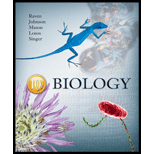
Concept explainers
Morphogenesis is the development of
a. growth form.
b. reproductive structures.
c. a phase change.
d. meristems.
Introduction:
The plants are the multicellular organisms that perform their functions and complete their life cycle. The plant starts forming from a seed and develops into a completely grown plant.
Answer to Problem 1U
Correct answer:
The development of growth forms is called the morphogenesis. Therefore, option a. is correct.
Explanation of Solution
Reason for the correct statement:
The development of the shape of an organism through different stages is called morphogenesis. The morphogenesis in the plants is the series of developmental changes that form the plant by the differentiation and organization of the cells.
Option a. is given as “growth form”.
As, “the morphogenesis is the developmental changes occurring in the plants, due to which the plants grow and functions properly”, is the right answer.
Hence, the option a. is correct.
Reasons for the incorrect statements:
Option b. is given as “reproductive structures”.
The reproductive development is known as the process of the development of the reproductive structures in the organisms. So, it is a wrong answer.
Option c. is given as “a phase change”.
The change in the phase in the plants is the transitional change to develop into a reproductive form from a vegetative form. So, it is a wrong answer.
Option d. is given as “meristems”.
In the embryogenesis, the apical meristems of the roots and shoots develop and differentiate to form the distinctive types of tissues in the plant. So, it is a wrong answer.
Hence, options b., c., and d. are incorrect.
The development of the growth forms of the plants is called morphogenesis.
Want to see more full solutions like this?
Chapter 41 Solutions
Biology
- What symbolic and cultural behaviors are evident in the archaeological record and associated with Neandertals and anatomically modern humans in Europe beginning around 35,000 yBP (during the Upper Paleolithic)?arrow_forwardDescribe three cranial and postcranial features of Neanderthals skeletons that are likely adaptation to the cold climates of Upper Pleistocene Europe and explain how they are adaptations to a cold climate.arrow_forwardBiology Questionarrow_forward
- ✓ Details Draw a protein that is embedded in a membrane (a transmembrane protein), label the lipid bilayer and the protein. Identify the areas of the lipid bilayer that are hydrophobic and hydrophilic. Draw a membrane with two transporters: a proton pump transporter that uses ATP to generate a proton gradient, and a second transporter that moves glucose by secondary active transport (cartoon-like is ok). It will be important to show protons moving in the correct direction, and that the transporter that is powered by secondary active transport is logically related to the proton pump.arrow_forwarddrawing chemical structure of ATP. please draw in and label whats asked. Thank you.arrow_forwardOutline the negative feedback loop that allows us to maintain a healthy water concentration in our blood. You may use diagram if you wisharrow_forward
- Give examples of fat soluble and non-fat soluble hormonesarrow_forwardJust click view full document and register so you can see the whole document. how do i access this. following from the previous question; https://www.bartleby.com/questions-and-answers/hi-hi-with-this-unit-assessment-psy4406-tp4-report-assessment-material-case-stydu-ms-alecia-moore.-o/5e09906a-5101-4297-a8f7-49449b0bb5a7. on Google this image comes up and i have signed/ payed for the service and unable to access the full document. are you able to copy and past to this response. please see the screenshot from google page. unfortunality its not allowing me attch the image can you please show me the mathmetic calculation/ workout for the reult sectionarrow_forwardIn tabular form, differentiate between reversible and irreversible cell injury.arrow_forward
 Concepts of BiologyBiologyISBN:9781938168116Author:Samantha Fowler, Rebecca Roush, James WisePublisher:OpenStax College
Concepts of BiologyBiologyISBN:9781938168116Author:Samantha Fowler, Rebecca Roush, James WisePublisher:OpenStax College
 Biology (MindTap Course List)BiologyISBN:9781337392938Author:Eldra Solomon, Charles Martin, Diana W. Martin, Linda R. BergPublisher:Cengage Learning
Biology (MindTap Course List)BiologyISBN:9781337392938Author:Eldra Solomon, Charles Martin, Diana W. Martin, Linda R. BergPublisher:Cengage Learning Biology: The Dynamic Science (MindTap Course List)BiologyISBN:9781305389892Author:Peter J. Russell, Paul E. Hertz, Beverly McMillanPublisher:Cengage Learning
Biology: The Dynamic Science (MindTap Course List)BiologyISBN:9781305389892Author:Peter J. Russell, Paul E. Hertz, Beverly McMillanPublisher:Cengage Learning





